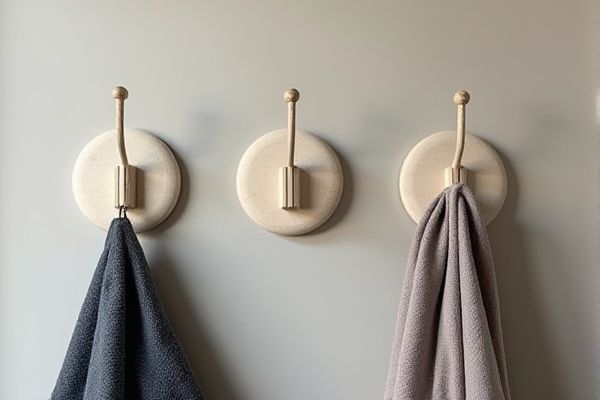
A double hook offers enhanced security and load distribution compared to a single hook, making it ideal for heavy-duty lifting tasks where safety is paramount. Explore the rest of the article to understand which hook suits Your specific needs and applications best.
Table of Comparison
| Feature | Double Hook | Single Hook |
|---|---|---|
| Design | Two hooks allow for double attachment points | One hook for single attachment |
| Strength | Higher load capacity due to dual hooks | Lower load capacity, designed for lighter loads |
| Use Case | Heavy-duty applications, secure hold | Light-duty applications, simple securing |
| Complexity | More complex to install and use | Simple design, easy installation |
| Cost | Typically higher due to design complexity | Generally more affordable |
| Weight | Heavier because of extra material | Lighter, more compact |
Double Hook vs Single Hook: An Overview
Double hooks feature two barbed points on a single shank, increasing the chances of securing a catch by providing enhanced grip and stability compared to single hooks. Single hooks are simpler, lighter, and less prone to snagging, making them ideal for species with delicate mouths or environments with dense cover. Choosing between double and single hooks depends on target species, fishing technique, and environmental conditions to optimize catch efficiency.
Key Differences Between Double and Single Hooks
Double hooks feature two sharp points connected to a single shank, offering increased snagging potential and better hold on fish, compared to single hooks with one point designed for simpler, easier removal. Single hooks reduce the risk of injury to fish and allow for quicker release, making them ideal for catch-and-release fishing. You should choose double hooks for improved catch rates in rough conditions, while single hooks prioritize fish safety and simplicity.
Strength and Durability: Which Hook Wins?
Double hooks generally offer increased strength and durability compared to single hooks, as the twin points distribute pressure more evenly and reduce the risk of bending or breaking under heavy loads. Single hooks, although simpler, are more prone to deformation when subjected to intense stress, making them less reliable in demanding fishing scenarios. Choosing a double hook can enhance your fishing experience by providing greater resilience and a higher chance of securely landing bigger fish.
Hooking Efficiency: Double or Single?
Double hooks increase hooking efficiency by providing two points of contact, reducing the chance of fish escaping once bitten. Single hooks offer quicker and easier removal, minimizing injury to the fish, but may result in a lower hook-up rate compared to double hooks. Anglers targeting aggressive or hard-fighting species often prefer double hooks to maximize catch success.
Targeted Fish Species: Best Hook Choice
Choosing between a double hook and a single hook depends largely on the targeted fish species; double hooks are ideal for species with tougher mouths, such as saltwater predators like tuna and marlin, providing better hold and reducing hook loss. Single hooks work best for species with smaller or softer mouths, like bass or trout, offering easier hook removal and less injury. Your best hook choice aligns with the specific fish behavior and habitat, ensuring optimal catch efficiency and conservation.
Hooking Safety: Pros and Cons
Double hooks offer increased hooking security, reducing the risk of losing fish during a catch due to their multiple points of penetration. However, they can cause more injury to fish and are harder to remove, raising concerns for catch-and-release practices. Single hooks provide easier handling and lower injury rates, enhancing fish survival but may increase the chance of losing the catch in turbulent conditions.
Suitable Fishing Techniques for Each Hook
Single hooks are ideal for fishing techniques such as bait fishing, fly fishing, and trolling where precise hook placement and easy release are crucial. Double hooks are better suited for rigging soft plastics and swimbaits, providing increased hooking potential and better retention on aggressive fish. Anglers targeting species with sharp teeth or strong jaws often prefer double hooks for improved catch security in jigging or bottom fishing.
Environmental Impact: Double vs Single Hooks
Single hooks reduce harm to aquatic ecosystems by minimizing injury to fish and decreasing catch-and-release mortality rates. Double hooks often cause greater physical damage, increasing stress and potential long-term ecological consequences for fish populations. Choosing single hooks supports sustainable fishing practices, helping maintain biodiversity and preserve aquatic habitats for your future fishing endeavors.
Angler Preferences: Why Choose One Over the Other?
Anglers often prefer single hooks for their ease of use, reduced likelihood of snagging, and better compliance with fishing regulations in many regions. Double hooks attract anglers seeking increased hooking efficiency and improved bait presentation, especially for larger or more aggressive fish species. The choice ultimately depends on target species behavior, fishing environment, and personal handling preferences.
Final Verdict: Double Hook or Single Hook?
Choosing between a double hook and a single hook depends on your fishing goals and target species. Double hooks offer improved hook-up rates and better bait presentation, making them ideal for aggressive or large fish, while single hooks reduce fish injury and make catch-and-release easier. Your final verdict should weigh the benefits of increased catch efficiency against ethical considerations and local regulations.
 homyna.com
homyna.com